Kuro: The Color Black in Chanoyu – Part 1
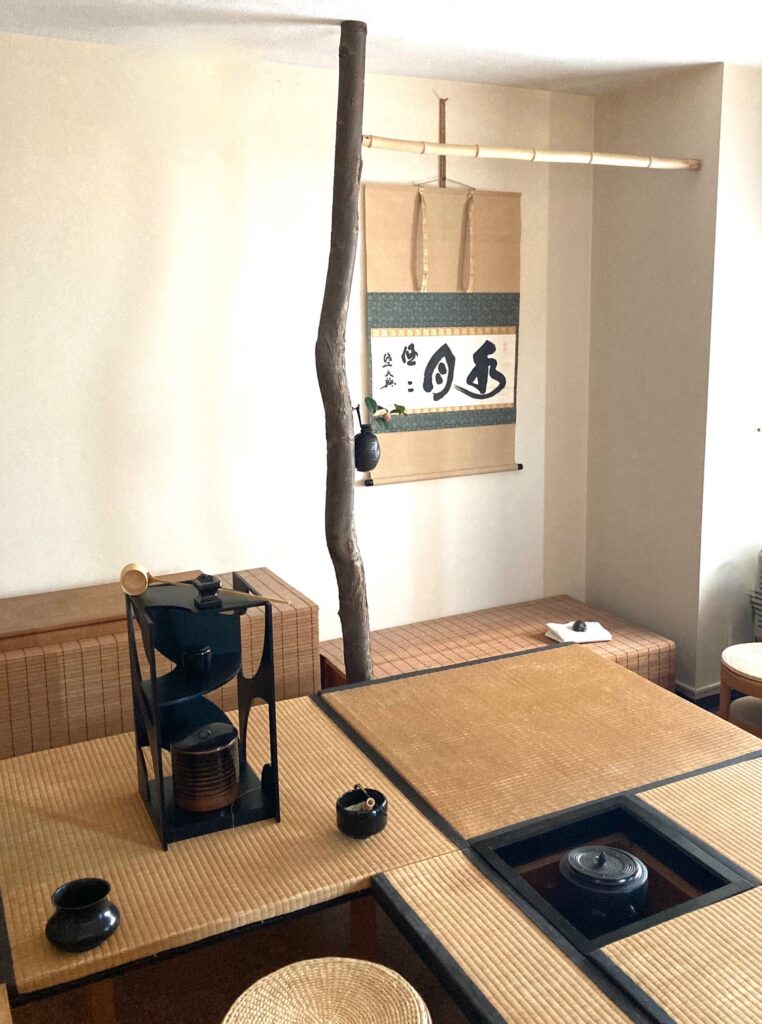
When preparing for a Tea presentation, there are many choices to be made. Considerations include the season, event, purpose, nature of the guest, style of formality, location, time, preference, and suitability of occasion. Assembling the utensils is called tori-awase, 取合せ, take-together, the selection of objects to be used together in a Chanoyu Tea presentation. Konomi, 好み, choice, like, favor, refers to the style, manner, color, form, etc. that is the selection according to one’s preferences of objects and procedures. Kata-mono, 型物, form-thing, is an acknowledged standard of objects.
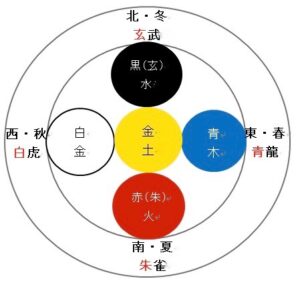
Color is a major aspect when choosing utensils, as colors have emotional and symbolic connotations for personal choice, tradition, beliefs, symbolism, etc. In Buddhism, there are five primary colors, go-shiki, 五色, that play major roles.
Black, kuro, 黒, is identified with the north; blue (blue/green), sei, 青, is east; red, aka, 赤, is south; white, shiro, 白, is west. Like many aspects of culture, there are differences in the actual colors and their symbolism. The most unsettled is the color green, which in Japanese is ao or sei, 青, which means both green and blue, and related hues. Other Japanese words for green are ryoku and midori for the Kanji, 緑, which is green by any standard; the prime example is ryoku-cha, 緑茶, green-tea. The five colors are customarily listed as moku ka do gon sui: Moku, 木, Wood, green, Ka, 火, Fire, red; Do, 土, Earth, white; Gon, 金, Gold, yellow; Sui, 水, Water, black. In another system Water is identified as white. Present in Chanoyu, are objects found in nature, or that have been somewhat altered, that manifest the five colors.

The subject in this study is the color black, and its presence in Chanoyu. The tori-awase of the utensils is my konomi, which tends to favor things that are black. Many of the utensils are kata-mono, 型物, standard examples, often attributed to the konomi of Sen no Rikyū.
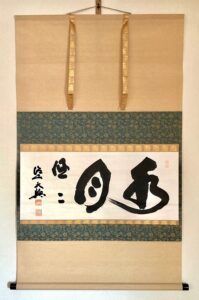
Kake-mono, 掛物, hang-thing; with calligraphy, ‘Sui-getsu Yū-yū,’ 水月悠々, Water-moon calm-calm, written in sumi, 墨, black ink, by Naka–gawa Ichi–shi–rō, 中川一志郎, Middle-river One-aspire-son, abbot of Ryō-tan-ji, 龍潭寺, Dragon-pool-temple, Hiko-ne, 彦根, Lad-root. The ichi-mon-ji, 一文字, one-letter-character, has a gold leaf pattern named, ‘kaku-ryū kin–ran’, 角龍金襴, corner-dragon gold-brocade, which has a somewhat obscure connection for the Year of the Dragon. The name of the temple, Dragon Pool, metaphorically brings the dragon into the Tea room for 2024, a Tatsu-doshi, 辰年, Dragon-year.
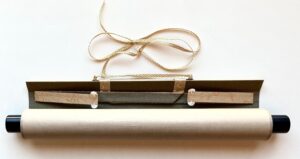
Partially rolled kake-jiku, 掛軸, hang-scroll, showing the folded fū-tai, 風帯, wind-strap, with white thread ‘tsuyu’, 露, dew, frills. The ends of the jiku, 軸, scroll, are lacquered black, which is a common feature of scrolls; some scroll ends are sheathed in metal. Note the very small metal hangers, kan, 鐶, metal ring, with attached kake-o, 掛緒, hang-cord, and maki-o, 巻緒, wrap-cord.
By happenstance, all five colors are present in the scroll and the mounting, hyō-gu, 表具, front-means. The five colors, go-shiki, 五色, are black, white, red, yellow, and blue/green. Red is present in the red ink stamps, ra-kkan-in, 落款印, drop-conclusion-stamp, that appear on most scrolls. In addition, the kakemono manifests the Go-gyō, 五行, Five-transitions, the five physical elements, if only by reference in some instances. Earth is the source of every thing. Water is used to write in ink, and the thread frill ‘dew’, suggests a form of water. Metal is found in the kan, metal loop hangers, and the gold leaf brocade, kinran. Wood is present in the jiku, scroll and in the half-moon rod, ha-ssō, 八双, eight-pair, from which the scroll hangs.
The hanging scroll with fūtai, pendant straps, manifests the Go-rin, 五輪 , Five-rings, principles. Earth is symbolic of the foundation of all things, the lower part of the scroll is called chi, 地神, earth, the upper area is called ten, 天, heaven. The ink is made of soot, which implies fire, mixed with water, which In, negative, that changes to dry, Yō. positive. Wind is alluded to with the fūtai, wind-straps. The void may be found in the metal rings of the kan. The escutcheon of the kan is patinated black and is often in the shape of rhombus, hana-bishi, 花菱a, flower-diamond.
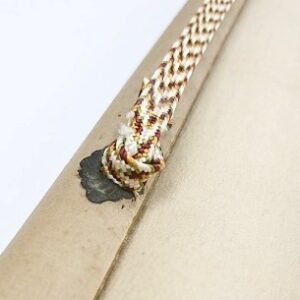
The speckled cord is called taku-boku, 啄木, peck-wood. It is said that in a former life, the Buddha was a woodpecker.
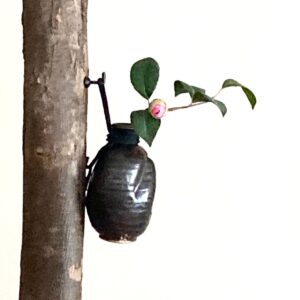
Hana-ire, 花入, flower-receptacle, ceramic bottle with varied black glaze by Ya-be Makoto, 矢部誠, Arrow-guild Truth, Boxford, Mass; H. 5 sun kane-jaku. The vase is hung from a ori-kugi, 折釘, fold-hook, in the trunk of a katsura, 桂, tree, which, in lore, is believed to grow on the moon.
Kō-gō, 香合, incense-gather, ceramic, covered container in the form of the figure of the Buddhist monk, Ho-tei, 布袋, Cloth-bag, seated on his bag of treasures, wearing a black robe, typical of Buddhist clergy, Raku-yaki, 楽焼, Pleasure-fired; width 1.8 sun kane-jaku. Acknowledged Tea Masters may be permitted to wear a ji-ttoku, 十徳, ten-virtues, a black silk jacket adapted from a Buddhist priest’s garment. Hotei is one of the Shichi-fuku-jin, 七福神, Seven-fortune-gods, who figure prominently in the New Year.
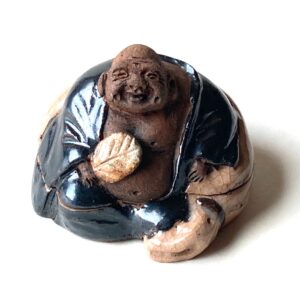
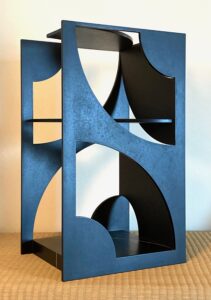
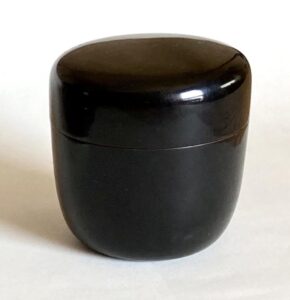
Cha-ki, 茶器, tea-contained, Rikyū-gata chū-natsume, 利休形中棗, Rikyū-form middle-jujube, ovoid, covered container lacquered black throughout; H. 1.8 sun kujira-jaku. This tea container is used for both usu-cha, 薄茶, thin-tea, and koi-cha, 濃茶, thick-tea. The number 18 in Japanese is jū-hachi, 十八, ten-eight, which can be written together to form the Kanji for ki, 木, tree, which is symbolic of ‘life’. The natsume has no corners, so that it manifests a kind of Infinity in Space and Time.
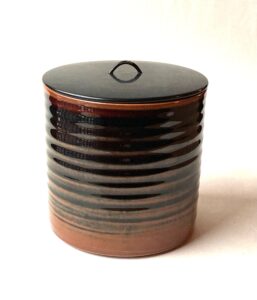
Mizu-sashi, 水指, water-indicate, hitoe-guchi, 単口, one layer-opening, porcelain vessel with black to brown glaze, Se-to-yaki, 瀬戸焼, Rapids-gate-fired, signed Izumi gama, 泉窯, spring-kiln; H. 5 sun kane-jaku, with a black nuri-buta, 塗蓋, lacquer-lid, which acts like a mirror. The arch handle, tsumami, 摘み, pinch, reflected in the lid forms a circle, which is a symbol of water, and is a manifestation of In and Yō, 陰 陽, Yin and Yang, negative and positive.
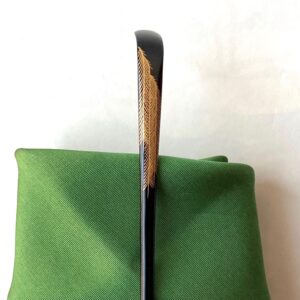
Cha-shaku, 茶杓, tea-scoop, susu-dake, 煤竹, smoked bamboo with middle node, the back lacquered black with a design in gold of a willow branch, yanagi no eda, 柳の枝, willow-’s-branch. Displayed on a green fuku-sa, 古帛紗, cloth-gauze.
A variety of willow tree is salix negra, in Japanese kuro-yanagi, 黒柳, black-willow. Its catkins are black.
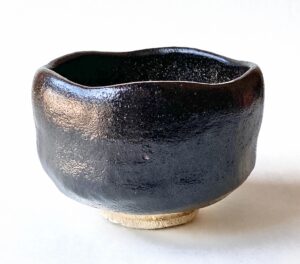
Kuro-raku cha-wan, 黒楽茶碗, black-pleasure tea-bowl, ceramic bowl with five crests and valleys on the rim, and black glaze, by Yoshi-mura Sō-Raku, 吉村宗楽, Luck-village Sect-pleasure, Kyōto; diam. 4 sun kane-jaku: made for and marked Gin-kaku-ji, 銀閣寺, Silver-pavilion-temple. In the temple garden is the Ryū-hai-kyō, 龍背橋, Dragon-back-bridge, a small bridge over the pond near the Silver Pavilion. In the temple garden is the Ryū-hai-kyō, 龍背橋, Dragon-back-bridge, a small bridge over the pond near the Silver Pavilion. The principal votive figure in the Ginkaku is Kannon, who is closely associated with the dragon: Ki-ryū Kan-non, 騎龍観音, Ride-dragon See-sound.
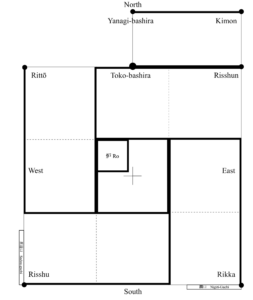
Diagram of a yo-jō-han, 四畳半, four-half-tatami, showing the directions. The tokonoma is in the north toward the east to protect the room from the harsh winds from the northeast. According to Asian geomancy and the Eki-kyō, I Ching, 易経, Change-sutra, and its trigrams, ha-kke, 八卦, eight-signs, the north is identified with the trigram Kan, 坎, Abyss.
Believed to be the first yo-jō-han, 四畳半, four-half-tatami, designated for the service of tea, was at the Tō-gu-dō, 東求堂, East-quest-hall, of Gin-kaku-ji, 銀閣寺, Silver-pavilion-temple, [1482] The Tea room is named Dō-jin-sai, 同仁斎, Equal-benevolence-room. The room does not have a tokonoma, but a window with a desk for reading Buddhist texts. The arrangement of the tatami has the han-jō, 半畳, half-tatami, in the center. The other four tatami are laid so that a full tatami is parallel to the shelf of the sho-in, 書院, write-room. This arrangement is in the pattern of the Man-ji, 卐字, ‘cornered cross’-character.
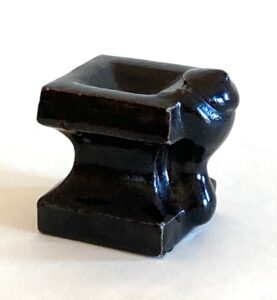
Futa-oki, 蓋置, lid-place, square, ceramic object in the form of a well with a figure peering over its edge, called ‘I-kkan–jin’, 一閑人, One-idle-person, glazed black throughout, Raku-yaki, 楽焼, Pleasure-fired, unmarked; well H. 1.8 sun kane-jaku. The piece is modeled on an incense burner. The figure represents an enlightened Buddhist monk who left a temple to safeguard children at a well. When used to support the kettle lid, the piece is turned on its side with the head toward the hearth.
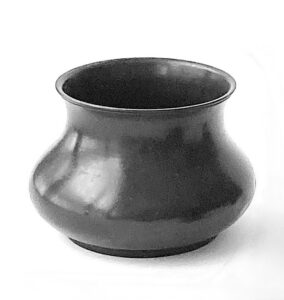
Ken-sui, 建水, build-water, waste water vessel, in the form called e-fugo, 餌畚, feed-bag, black-patinated bronze, signed Naka-gawa Jō-eki, 中川浄益, Middle-river Pure-benefit, Kyōto. Also called a koboshi, 零, spiller, that may be wordplay on ko-bō-shi, 小法師, small-law-master, a black-robed Buddhist.
For further study see upcoming articles on The Color Black in Chanoyu and also: Tea in January and the Willow, Rikū Chū Natsume

